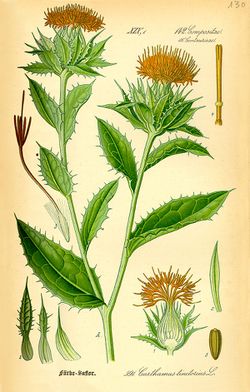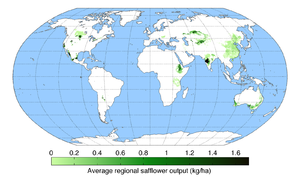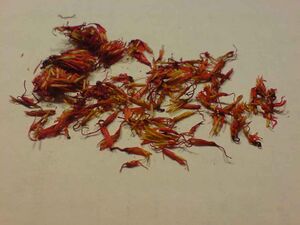عصفر
| Safflower | |
|---|---|
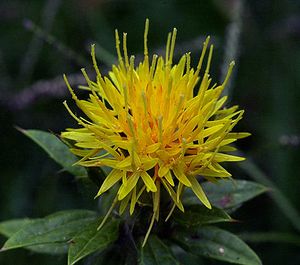
| |
| التصنيف العلمي | |
| مملكة: | |
| (unranked): | |
| (unranked): | |
| (unranked): | |
| Order: | |
| Family: | |
| Tribe: | |
| Genus: | |
| Species: | C. tinctorius
|
| Binomial name | |
| Carthamus tinctorius | |
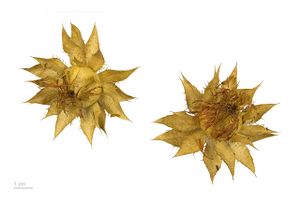
عصفر (Safflower) أو قرطم هو خيوط الأجزاء التكاثرية في زهور العصفر لون العصفر يكون أصفر أو أحمر وحسب نوع الزهرة, والعصفر مادة ملينة ومدرة للبول . وكان شاي العصفر يعطي للأطفال والكبار في الحمي والحصبة والطفح الجلدي .وعجينته من الدقيق توضع لعلاج الدمامل .وتتناول الوهور كسفوف أو خليط مع زيت الزيتون لعلاج الشريان التاجي والجلطات ومشاكل العادة الشهرية ونزول الطمث واليرقان وآلام البطن بعد الولادة . ويعالج الكدمات وآلام الجلد وإلتهابه والجروح وآلام المفاصل وتيبسها. ويقلل تجلط الدم .
يستخرج من العصفر صبغات تستعمل في انتاج مواد التجميل.
الانتاج
In 2020, global production of safflower seeds was 653,030 tonnes, led by Kazakhstan with 35% of the world total (table). Other significant producers were Russia and Mexico, with 28% of world production combined.
| البلد | البذور بالطن |
|---|---|
| 226,739 | |
| 96,636 | |
| 86,793 | |
| 67,040 | |
| 44,000 | |
| الإجمالي | 653,030 |
الاستخدامات
Traditionally, the crop was grown for its seeds, and used for coloring and flavoring foods, in medicines, and making red (carthamin) and yellow dyes, especially before cheaper aniline dyes became available.[3]
زيت قابل للأكل
For the last fifty years or so,[بحاجة لمصدر] the plant has been cultivated mainly for the vegetable oil extracted from its seeds. Safflower seed oil is flavorless and colorless. It is used mainly in cosmetics and as a cooking oil, in salad dressing, and for the production of margarine.[بحاجة لمصدر] INCI nomenclature is Carthamus tinctorius.[بحاجة لمصدر]
There are two types of safflower that produce different kinds of oil: one high in monounsaturated fatty acid (oleic acid) and the other high in polyunsaturated fatty acid (linoleic acid). Currently the predominant edible oil market is for the former, which is lower in saturated fats than olive oil. The latter is used in painting in the place of linseed oil, particularly with white paints, as it does not have the yellow tint which linseed oil possesses.[بحاجة لمصدر]
In one review of small clinical trials, safflower oil consumption reduced blood low-density lipoprotein levels – a risk factor for cardiovascular diseases – more than those seen from butter or lard consumption.[4]
| أدنى | أقصى | ||
|---|---|---|---|
| الأحماض الدهنية المشبعة | Myristic C14:0 | 0 | 0.5 |
| Palmitic C16:0 | 4 | 8.6 | |
| Stearic C18:0 | 1.7 | 2.6 | |
| Monounsaturated fatty acids | Oleic C18:1 | 8.1 | 18.4 |
| Eicosenoic C20:1 | 0 | 0.2 | |
| Polyunsaturated fatty acids | Linoleic C18:2 | 71.6 | 83.7 |
| Arachidonic C20:4 | 0 | 0.4 | |
| Linolenic C18:3 | 0 | 0.1 |
| % | ||
|---|---|---|
| Saturated fatty acids | Palmitic C16:0 | ~5 |
| Stearic C18:0 | ~2 | |
| Monounsaturated fatty acids | Oleic C18:1 | ~78 |
| Polyunsaturated fatty acids | Linoleic C18:2 | ~13 |
الزهور للاستهلاك البشري
Safflower flowers are occasionally used in cooking as a cheaper substitute for saffron, sometimes referred to as "bastard saffron".[11]
The dried safflower petals are also used as a herbal tea variety.
صبغة من الزهور
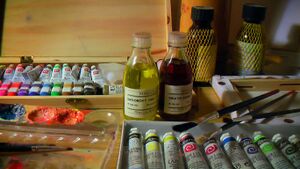
Safflower petals contain one red and two yellow dyes. In coloring textiles, dried safflower flowers are used as a natural dye source for the orange-red pigment carthamin. Carthamin is also known, in the dye industry, as Carthamus Red or Natural Red 26.[12] Yellow dye from safflower is known as Carthamus yellow or Natural Yellow 5.[13] One of the yellow pigments is fugitive and will wash away in cold water. The dye is suitable for cotton, which takes up the red dye, and silk, which takes up the yellow and red color yielding orange. No mordant is required.[14]
In Japan, dyers have long utilised a technique of producing a bright red to orange-red dye (known as carthamin) from the dried florets of safflower (Carthamus tinctorius).[بحاجة لمصدر] Darker shades are achieved by repeating the dyeing process several times, having the fabric dry, and redyed.[بحاجة لمصدر] Due to the expensive nature of the dye, safflower dye was sometimes diluted with other dyestuffs, such as turmeric and sappan.[15]
زيت يتحلل حيوياً
In Australia in 2005, CSIRO and Grains Research and Development Corporation launched the Crop Biofactories initiative to produce 93% oleic oil for use as a biodegradable oil for lubricants, hydraulic fluids, and transformer oils, and as a feedstock for biopolymers and surfactants.[16]
انظر أيضاً
المراجع
- ^ "Tropicos". Missouri Botanical Garden, St. Louis, MO. 2016. Retrieved 16 June 2016.
- ^ "World production of safflower seeds in 2020; World Regions/Crops/Production from pick lists". United Nations Food and Agriculture Organization, Statistics Division (FAOSTAT). 2022. Retrieved 16 May 2022.
- ^ عصفر, p. 168, في كتب گوگل in Zohary, Daniel; Weiss, Ehud; Hopf, Maria (2012). "Dye crops". Domestication of Plants in the Old World. pp. 166–168. doi:10.1093/acprof:osobl/9780199549061.003.0009. ISBN 978-0-19-954906-1.
- ^ Schwingshackl, Lukas; Bogensberger, Berit; Benčič, Aleksander; Knüppel, Sven; Boeing, Heiner; Hoffmann, Georg (September 2018). "Effects of oils and solid fats on blood lipids: a systematic review and network meta-analysis". Journal of Lipid Research. 59 (9): 1771–1782. doi:10.1194/jlr.P085522. PMC 6121943. PMID 30006369.
- ^ "Appendix B. Fatty Acid Composition of Dietary Fats and Oils". The Fats of Life. 2019. pp. 219–221. doi:10.36019/9780813549194-009. ISBN 9780813549194. S2CID 241747841.
- ^ Sabzalian, Mohammad R.; Saeidi, Ghodratollah; Mirlohi, Aghafakhr (August 2008). "Oil Content and Fatty Acid Composition in Seeds of Three Safflower Species". Journal of the American Oil Chemists' Society. 85 (8): 717–721. doi:10.1007/s11746-008-1254-6. S2CID 85260715.
- ^ Mailer, R., Potter, T., Redden, R., & Ayton, J. (2008). Quality evaluation of safflower (Carthamus tinctorius L.) cultivars. In Paper presented at the 7th international safflower conference (Wagga Wagga, NSW) قالب:S2cid
- ^ Ben Moumen, Abdessamad; Mansouri, Farid; Richard, Gaetan; Abid, Malika; Fauconnier, Marie-Laure; Sindic, Marianne; El Amrani, Ahmed; Serghini Caid, Hana (March 2015). "Biochemical characterisation of the seed oils of four safflower ( Carthamus tinctorius ) varieties grown in north-eastern of Morocco". International Journal of Food Science & Technology. 50 (3): 804–810. doi:10.1111/ijfs.12714. hdl:2268/175051.
- ^ Coşge, Belgin; Gürbüz, Bilal; Kiralan, Mustafa (2007). "Oil Content and Fatty Acid Composition of Some Safflower (Carthamus tinctorius L.) Varieties Sown in Spring and Winter". International Journal of Natural and Engineering Sciences. 1 (3): 11–15.
- ^ Salaberría, F., Constenla, D., Carelli, A.A. et al. Chemical Composition and Physical Properties of High Oleic Safflower Oils (Carthamus tinctorius, Var. CW88-OL and CW99-OL). J Am Oil Chem Soc 93, 1383–1391 (2016). https://doi.org/10.1007/s11746-016-2886-6 |url=https://link.springer.com/article/10.1007/s11746-016-2886-6
- ^ E.g. "safflower" in Webster's Dictionary, year 1828 Archived 2013-05-08 at the Wayback Machine. E.g. "bastard saffron" in The Herball, or General Historie of Plantes, by John Gerarde, year 1597, pages 1006-1007.
- ^ "Carthamus red; In: Compendium of Food Additive Specifications. Addendum 5. (FAO Food and Nutrition Paper - 52 Add. 5)". FAO/WHO Expert Committee on Food Additives. 1997. Retrieved September 20, 2016.
- ^ "Carthamus yellow; In: Compendium of Food Additive Specifications. (FAO Food and Nutrition Paper - 52 Add. 5)". FAO/WHO Expert Committee on Food Additives. 1997. Retrieved April 7, 2022.
- ^ "Dyeing with Safflower". wildcolours.co.uk. 19 April 2021. Retrieved 26 January 2022.
- ^ Arai, Masanao; Iwamoto Wada, Yoshiko (2010). "BENI ITAJIME: CARVED BOARD CLAMP RESIST DYEING IN RED" (PDF). Textile Society of America Symposium Proceedings. University of Nebraska - Lincoln. Archived from the original on 2 November 2021.
- ^ Lee, Tim (7 June 2020). "Safflower oil hailed by scientists as possible recyclable, biodegradable replacement for petroleum". ABC News. Landline. Australian Broadcasting Corporation. Retrieved 7 June 2020.
وصلات خارجية
 Media related to Carthamus tinctorius at Wikimedia Commons
Media related to Carthamus tinctorius at Wikimedia Commons- Safflower field crops manual, University of Wisconsin, 1992
- McGuire, Patrick E.; Damania, Ardeshir B.; Qualset, Calvin O., eds. (2012). Safflower in California (PDF).
- Lewin, Geertje; Joel, Madeleine; Peter, Birgit; Lützow, Manfred (September 2021). "Food grade safflower concentrate: No evidence for reproduction and early developmental toxicity". Reproductive Toxicology. 104: 155–165. doi:10.1016/j.reprotox.2021.01.009. PMID 33515695.
- Articles with unsourced statements from October 2021
- Articles with unsourced statements from June 2020
- Articles with unsourced statements from May 2018
- Plant dyes
- Food colorings
- Carthamus
- Vegetable oils
- Plants used in traditional Chinese medicine
- Plants used in Ayurveda
- Plants described in 1753
- Oil seeds
- Abortifacients
- زيوت الطهي
- نباتات طبية
- زيوت نباتية
- نبيت نـِپال
- نبيت الهند
- Edible Asteraceae
- Terms with Arabic origin
- بهارات
